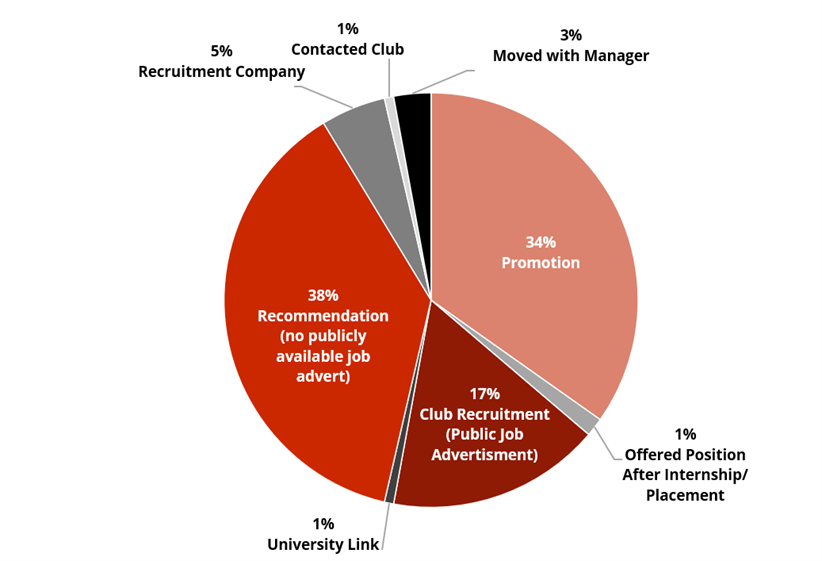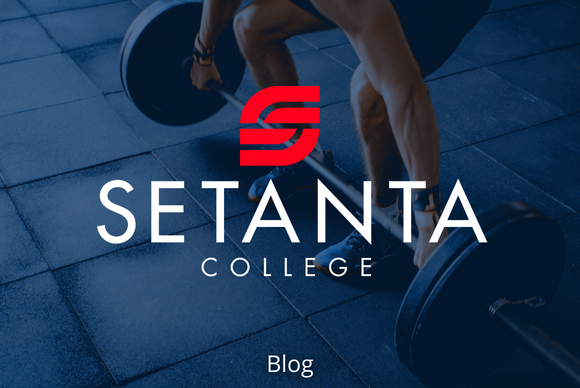Employment Methods
In April, I published a report in partnership with Setanta College, which can be downloaded in full here. The report was the result of a survey in which 138 people who have strength and conditioning or sports science roles in British football responded to. The aim was to put some objectivity on the often-held conversations around salaries, nepotism (the practice among those with power or influence of favouring relatives or friends, especially by giving them jobs), and working conditions in elite football here in the UK.
We collected data on education level, accreditation status, age, gender, internship experience, and the all-important salary. However, the starkest of all the information that was collected was that of ‘employment method’ (figure 1); how those in these positions got their current role.

Before diving any deeper into figure 1 and what it means for new graduates wanting to get into the fields of strength and conditioning and sports science, a few misunderstandings must be made clear. In the survey, there were only four options for people to choose from ‘recommendation’, ‘club recruitment’, ‘promotion’, ‘recruitment company’ and ‘other’. It was in the ‘other’ option where a number of respondents answered, ‘offered position after internship, ‘moved with manager’, ‘university link’, and ‘contacted club’. This does not mean that only 1% of those currently in a job got their current role immediately after an internship as many respondents could have classed that as ‘promotion’. This methodological issue will be amended in future surveys to reduce confusion.
As a new graduate, this graph may look a little bit scary. ‘How can I get a job if 38% of roles are based on a recommendation – who is going to recommend me?’ But this fact is not confined to our industry. Research from LinkedIn in 2016 showed that 70% of people hired at a company already had a connection in place. So, thinking that is strictly a sport problem is false.
So, what is the answer? Networking is a term that gets thrown around. It’s the holy grail of getting a job. However, it often creates an image of awkward conversations at the coffee machine at a conference, handing out business cards to as many people that will accept them, or collecting phone numbers. None of those things will lead to getting a job. And this is where networking has to be reframed. It can’t be about getting a job. That narrative must be reframed as it leads to looking at fellow coaches and thinking, ‘what can he/she do for me?’ That must be reframed to, ‘how can I offer value?’.
Offering value can come in various forms. Two great examples of how graduates can offer value are seen in this short video below with Des Ryan (Director of Coaching and Performance at Setanta College), David Slemen (industry recruiter), and Chris Bishop (Chairman of the UKSCA). This clip was taken from a MasterMIND I hosted where we discussed career development and employment. However, there are other ways it can be done and thankfully for graduates, a lot of the work has already been done.
Every student puts their blood, sweat and tears into their dissertation. Its often thousands of words long and has taken months and months to produce. However, once it gets handed in, 99% of them get forgotten about. This document can be the start of a journey into a particular area and can be utilised to great effect on a ‘networking’ journey.
4 Ways to Start Networking Now
Here are 4 ways that graduates can start networking now.
- At many industry events, whether that be the UKSCA conference or BASES conference to name just two, coaches and researchers produce posters of their research. These posters often represent unpublished research and are put on display at conferences so attendees can walk around during the breaks and see what amazing work is being done in the field. With the help of a supervisor, a dissertation can be repurposed and presented at one of the conferences mentioned above. This will immediately put graduates among more experienced coaches and researchers and will allow them to talk about their work to potentially influential people in the industry.
- This poster can then be repurposed again in the form of an infographic. Infographics have become an incredible way to communicate complex research in an understandable, bitesize way. Yann Le Meur has revolutionised this area with his thousands of infographics. This has led to him becoming who of the most followed sports scientists on social media. A dissertation poster can be a graduate’s key into that world. Programmes such as Canva make this process easy and even provide templates for infographics. Creating an infographic then allows graduates to publish it across social their media channels.
- Sharing on social media is crucial. Twitter has become the go-to place for researchers and coaches to keep up to date with work being done by their peers. If there was any research that featured in the dissertation and therefore influenced the infographic, send the infographic to the authors.
- Sending the infographic directly to those who have influenced it can be a great way to spark conversation with influential people, learn from them and share information on topics where there is a mutual passion. It can also be a great way to figure out where the information gaps are on this topic. Knowing this may allow graduates to plan ways they can plug those gaps through additional research, blog articles or other infographics.
Despite the initial scare when looking at figure 1 and then the confusion around where to start with networking, there are positives for new graduates. And as shown in the list above, a lot of the work has already been done. In addition to these four points, there are many other ways to network and more crucially, offer value. They include:
- Writing a blog on an area of interest and sharing it with peers and other coaches who specialise in that area.
- Creating infographics of other people’s work.
- Summarising podcast episodes and sharing them in a creative way.
Offer value, offer value, offer value.
You can download the full report to understand more about the demographics and salaries of strength and conditioning coaches and sports scientists working in British football here.
Study S&C with Setanta College
Learn more about our Strength & Conditioning courses by downloading a brochure below.


Leave A Comment